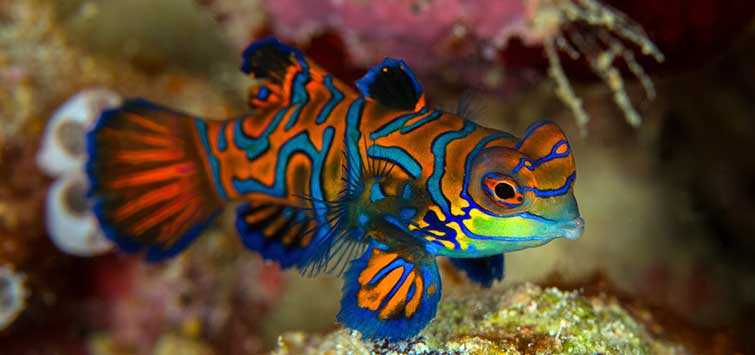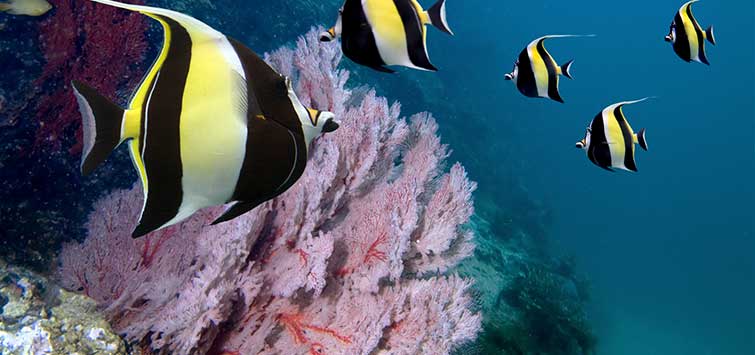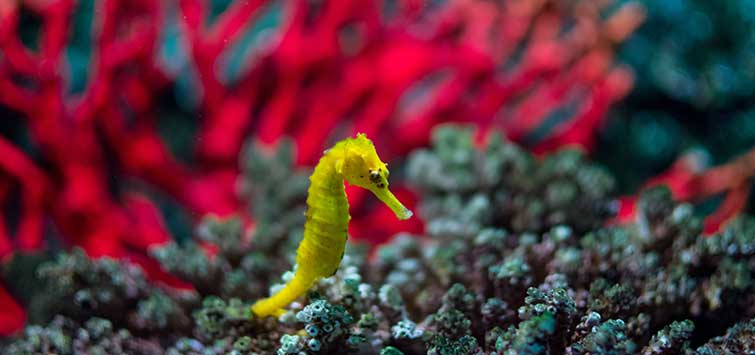The Salt Creep: Hard-to-Feed Fish
Author: Jeff Kurtz
The first thing every child asks when looking at a tank full of fish is, “Can I feed them?” At public aquariums, feeding demonstrations are always among the most popular attractions—especially when that demonstration involves sharks, moray eels, or other toothy carnivores.
Though few will admit it, many experienced hobbyists still experience that same childlike joy whenever they place food in their home aquarium and the fish go into a mini feeding frenzy. Perhaps this is so because feeding is the one opportunity for aquarists to get beyond the glass panes and “interact” with their fish. Whatever the reason, feeding is one of the most rewarding aspects of our hobby.
It can also be one of the most challenging.
The Challenge of Feeding
With some marine fish species, what would seem to be the simplest aspect of husbandry—getting them to eat—proves to be extremely challenging if not downright impossible. Though today’s marine aquarist has a plethora of foods at his or her disposal, some of which are formulated specifically to meet the nutritional needs of hard-to-feed species, there are many commonly sold fish that continue to pose a serious challenge when it comes to feeding, or that will refuse to feed under any circumstances.
Given that many beautiful and fascinating marine species will readily adapt to standard aquarium fare, hobbyists should think long and hard before buying fish that are notoriously finicky or reluctant feeders.
Feeding challenges take many forms. Some can be overcome with a little determination and ingenuity while others should preclude the purchase of a given species. Following are some of the feeding challenges you might encounter along with sample species that are known to present them.
The Highly Specialized Feeder
The diet of this type of feeder includes items that are very difficult, if not impossible, for the average aquarist to provide. For example, the fish may feed primarily or exclusively on coral polyps, sponges, tubeworms, or other items.
Butterflyfishes
Many of the butterflyfish, such as Meyer’s butterflyfish, the exquisite butterflyfish, and Bennett’s butterflyfish (Chaetodon meyeri, C. austriacus, and C. bennetti respectively), fall into the category of obligate corallivores, which means they feed exclusively on coral polyps. Unless you’ve got a steady supply of corals you don’t mind parting with, these species, along with certain others in their genus, have no place in the aquarium. Be sure to research carefully the dietary needs of any butterflyfish before buying.
Oxymonacanthus longirostris
Another obligate coral feeder that unfortunately keeps finding its way into dealer’s tanks is the orange-spotted filefish Oxymonacanthus longirostris. In fact, just recently I saw a specimen for sale in one of the major chain pet stores. Passersby would ooh and aah over this delightfully odd little orange-and-blue fish with the long nose. Of course, no information was posted to alert potential buyers to its extremely specialized diet (which could read: “Warning! This species is going to die in your tank!), and I doubt the teenage staffers in the department would have known any better, either.
The All-Day-Every-Day Feeder
Let’s face it, the most common fish-feeding regimen is twice a day—once in the morning before rushing off to work or school, and once in the evening when we return. Twice-a-day feedings may be fine for many marine fish species, but for those that are adapted to grazing or foraging continuously throughout the day, this may be grossly inadequate and may lead to nutritional deficits and, eventually, death from starvation.
Many anthias species fall into this category. Anthias tend to feed by continuously snatching zooplankton drifting in the water column. That means that in captivity, they must be fed numerous times throughout the day and often must be enticed to feed initially with live food, such as mysid shrimp or adult brine shrimp, before they can be weaned onto frozen items. It’s not necessarily that their nutritional needs can’t be met in the aquarium. It’s just that their eating habits tend to conflict with the time constraints (and, perhaps, the motivation level) of the average hobbyist.
A potential solution to this problem is to use an auto feeder to dispense feedings throughout the day. While many of these devices are designed to dispense dried foods, such as flakes, pellets, and freeze-dried items, some can be used for gradually dispersing frozen food, such as frozen cyclops, over the course of several hours.
Live Foods Only, Please!
This next type of problem feeder will only accept living foods or may be difficult to wean from live foods onto fresh or frozen offerings. Such feeders often fall into the previous category of needing to eat constantly throughout the day, as well.
The biggies that come to mind here are the mandarinfish Synchiropus spp.(and other dragonets) and the seahorses. Mandarins feed continuously on tiny crustaceans such as amphipods and copepods, buzzing around the rockwork like little piscine hummingbirds in search of prey items. For all intents and purposes, they don’t even recognize non-living items as potential food sources. Trouble is, once they’ve exhausted the supply of tiny fauna in the tank—an inevitability in most home aquariums—they begin to starve. And most aquarists don’t have the wherewithal to culture a steady supply of living foods to supplement the tank.
Mandarinfish
Oftentimes, death by starvation for the mandarinfish is a prolonged event, sometimes occurring over the course of many months, so the aquarist may be inclined to think all is going well until the specimen suddenly perishes. Some dedicated aquarists manage to keep these fish alive for relatively long periods, but for the average hobbyist, these little beauties are a poor choice.
Seahorses
Similarly, seahorses will often accept only live foods (or wean from them very reluctantly) and require multiple feedings throughout the day. That being said, enormous strides have been made in recent years in the captive breeding of seahorses. Captive-bred specimens are already acclimated to aquarium conditions and may even be adapted to eating frozen foods, which increases their odds of survival significantly. Still, seahorses—even captive-bred ones—require considerable dedication on the hobbyist’s part to provide the specialized conditions they need and to keep up with those frequent feedings.
The Reluctant Feeder
Some fish species are just notoriously reluctant to feed in a captive setting and almost invariably refuse all foods offered to the point of starvation and death—no matter how much effort and dedication you put into feeding. Hence, even expert professional aquarists won’t attempt to keep them.
Zanclus cornutus and Rhinomuraena quaesita
Two of the best-known representatives of this group are the Moorish idol Zanclus cornutus and the ribbon eel Rhinomuraena quaesita. I’ve been hearing and reading admonitions against keeping these species since I got into the aquarium hobby almost 25 years ago, and in all likelihood, such warnings date back much further than that. Yet, I continue to see them offered for sale.
Why the doomed-to-die (though admittedly beautiful) Moorish idol still tempts so many hobbyists is beyond me—especially when they have the option of purchasing the similar-looking longfin bannerfish Heniochus acuminatus (a.k.a. “the poor man’s Moorish idol”), which is very hardy, adaptable to aquarium conditions, and amenable to most meaty marine foods.
I’ve read a few accounts of hobbyists succeeding with R. quaesita by first offering it live feeder fish and then weaning it onto fresh, meaty foods of marine origin. But I’ve read many more accounts where this species simply refuses to feed and eventually perishes. Besides, you have to question what a hobbyist means by “succeeding with a species.” Does that mean keeping it alive for a year or so? Given the surprising longevity of many marine species (my percula clownfish, yellow-tail blue damsel, and yellow tang have been with me since 1997 and are still going strong), keeping a fish alive for a year or two can hardly be considered a success.
But I Am Eating!
In some cases, the problem isn’t that a fish won’t eat, but that it isn’t getting all the nutrition it needs from the foods being offered. The specimen may be gobbling up everything you offer yet still perishes as a result of a cumulative nutritional deficit. Sometimes the problem might be that there’s some nutritional element missing from the fish’s diet that is difficult to provide in captivity, or that the hobbyist isn’t providing a sufficiently varied diet.
Or, if sodium cyanide was used to facilitate the fish’s capture (an illegal practice that still happens more than we care to admit in areas such as the Philippines and Indonesia), its digestive system could have been damaged so severely that it can no longer extract nutrients from the food it eats. A cyanide-poisoned fish, if not killed outright on the reef, will often appear to be perfectly healthy and have a normal appetite but then die suddenly weeks or even months later.
As a hedge against nutritional deficits, it’s important to offer a variety of fresh, frozen, and dried foods. It’s even helpful to alternate the brands of foods offered, as formulas and ingredients vary. By alternating products, it’s less likely that you’ll omit important nutrients that your fish need to thrive.
Avoiding the purchase of cyanide-poisoned fish is a bit more of a challenge. However, a good way to be confident that a specimen has been collected in a reef-safe manner using sustainable collection techniques is to buy livestock certified by the Marine Aquarium Council (MAC) from a MAC-Certified retailer.
Do Your Homework!
By now, you’ve no doubt come to the realization that the successful feeding of some marine fish species is by no means a foregone conclusion. The best way to avoid ending up with a specimen that refuses to feed or perishes from malnutrition in spite of feeding is to research every livestock purchase thoroughly. That will continue to be my mantra as long as hard- or impossible-to-feed fish are offered for sale.
See the full article on TFH Digital http://www.tfhdigital.com/tfh/200711/#pg66

.png?h=595&iar=0&w=2781&hash=5FD5E69473BCC22199FBFA2FB71B6033)



